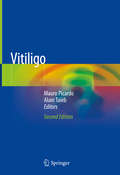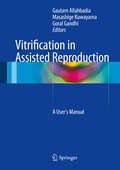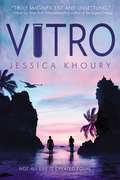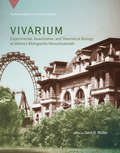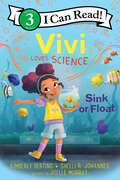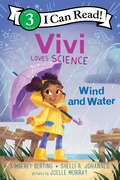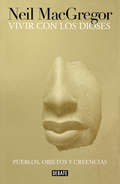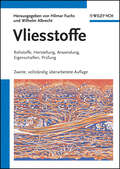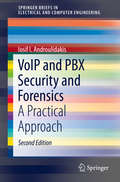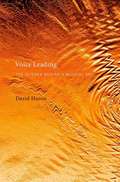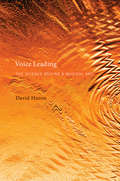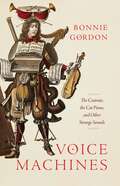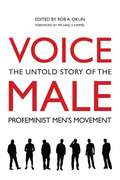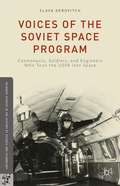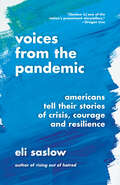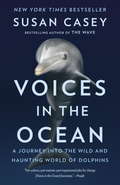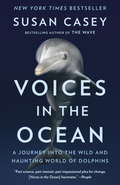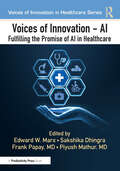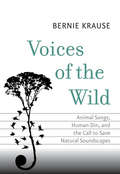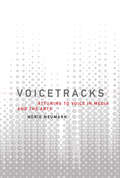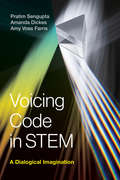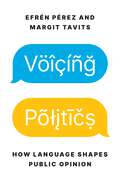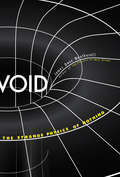- Table View
- List View
Vitiligo
by Alain Taïeb Mauro PicardoSince the first edition of this book was published, new knowledge has been gained on Vitiligo. This widely revised and updated second edition, written by worldwide experts in the field, fully reflects this progress. The apparently, simple and poorly symptomatic presentation of the disease has been a strong disadvantage to its study, as compared to other common chronic skin disorders such as psoriasis and atopic dermatitis. A good skin-based angle of attack is also lacking because generalized Vitiligo is clearly epitomizing the view of skin diseases as simple targets of a systemic unknown dysregulation (diathesis). This view has mostly restricted Vitiligo to the manifestation of an auto-immune diathesis and skin events, which are easily detected using skin biospies in most other situations, have not been precisely recorded, with the argument that a clinical diagnosis was sufficient for the management of the patient with Vitiligo. This richly illustrated second edition reflects the constant international effort to share the information gathered about this disorder at the clinical, pathophysiological and therapeutic levels. Its aim still being to bridge current knowledge at the clinical and investigative level, to point to the many unsolved issues, and to delineate future priorities for research.
Vitrification in Assisted Reproduction
by Gautam Allahbadia Masashige Kuwayama Goral GandhiAdvances in technology now offer promising solutions to deal with the chronological aging of the cell, tissue or organ to synchronize its existence and its use. This book covers the developments in and benefits of the latest vitrification technology and its extensive applications in reproductive medicine. Protocols of gametes (oocyte and sperm), embryos, blastocysts and ovarian tissue cryopreservation have been reviewed by leaders in the field. In order to address the escalation in cross-border reproductive tourism entailing the transfer of reproductive cells and tissues rather than the patient, the challenges, caution and emerging possibilities of nitrogen vapor shipment of vitrified cells have been discussed. Current perspectives on oocyte banking present the reader with options and solutions to effectively utilize these gametes despite the physiological deterrents. The versatile applications and potential of vitrification of human embryonic stem cells, discussed in the concluding chapter, is an exciting reality offered by vitrification to help overcome numerous stumbling blocks in the management of various disorders.
Vitro
by Jessica KhouryA death-defying tropical adventure delivers a frightening message about dabbling with creation from the talented author of Origin. On a remote island in the Pacific, Corpus scientists have taken test tube embryos and given them life. These beings--the Vitros--have knowledge and abilities most humans can only dream of. But they also have one enormous flaw. Sophie Crue is determined to get to Skin Island and find her mother, a scientist who left Sophie behind years ago. She enlists hunky charter pilot Jim Julien to take her there. But once on the island, Sophie and Jim encounter more than they bargained for, including a charming, brilliant Vitro named Nicholas and an innocent, newly awoken one named Lux. In a race for their lives, Sophie and Jim are about to discover what happens when science stretches too far beyond its reach.
Vivarium: Experimental, Quantitative, and Theoretical Biology at Vienna's Biologische Versuchsanstalt (Vienna Series in Theoretical Biology #19)
by Gerd MüllerThe scientific achievements and forgotten legacy of a major Austrian research institute, from its founding in 1902 to its wartime destruction in 1945.The Biologische Versuchsanstalt was founded in Vienna in 1902 with the explicit goal to foster the quantification, mathematization, and theory formation of the biological sciences. Three biologists from affluent Viennese Jewish families—Hans Przibram, Wilhelm Figdor, and Leopold von Portheim–founded, financed, and nurtured the institute, overseeing its development into one of the most advanced biological research institutes of the time. And yet today its accomplishments are nearly forgotten. In 1938, the founders and other members were denied access to the institute by the Nazis and were forced into exile or deported to concentration camps. The building itself was destroyed by fire in April 1945. This book rescues the legacy of the “Vivarium” (as the Institute was often called), describing both its scientific achievements and its place in history.The book covers the Viennese sociocultural context at the time of the Vivarium's founding, and the scientific zeitgeist that shaped its investigations. It discusses the institute's departments and their research topics, and describes two examples that had scientific and international ramifications: the early work of Karl von Frisch, who in 1973 won the Nobel Prize in Physiology or Medicine; and the connection to Cold Spring Harbor Laboratory in New York.ContributorsHeiner Fangerau, Johannes Feichtinger, Georg Gaugusch, Manfred D. Laubichler, Cheryl A. Logan, Gerd B. Müller, Tania Munz, Kärin Nickelsen, Christian Reiß, Kate E. Sohasky, Heiko Stoff, Klaus Taschwer
Vivi Loves Science (Loves Science)
by Kimberly Derting Shelli R. JohannesVivi loves science! In this STEM-themed picture book, part of a series about girls who love science, Vivi and her classmates go on a field trip to the ocean to investigate tide pools. A must-have for fans of Rosie Revere, Engineer and What Do You Do with an Idea? and anyone who loves to ask questions and learn about the world. Features a glossary and fun tide pool activity to do at home.In the companion to Cece Loves Science and Libby Loves Science, Vivi and her classmates take a field trip to the beach to study tide pools. With help from her teacher and a park ranger, Vivi and her friends make aquascopes, participate in a marine-inspired scavenger hunt, and learn about different species that call the ocean home.At the end of their trip, there’s one more surprise for Vivi! Full of fun facts about marine biology and conservation, Vivi Loves Science is a perfect pick for aspiring scientists, classrooms, and fans of Andrea Beaty’s Ada Twist, Scientist.Features a glossary and instructions on how to make your own aquascope and tide pool at home.
Vivi Loves Science: Sink or Float (I Can Read Level 3)
by Kimberly Derting Shelli R. JohannesVivi loves science! In this STEM-themed Level 3 I Can Read! title, Vivi and her friends visit the aquarium and are introduced to the concepts of density and buoyancy. A great choice for aspiring scientists, emerging readers, and fans of Andrea Beaty’s Ada Twist, Scientist. Includes activities, a glossary, and a fun experiment to do at home. Vivi loves science—and experimenting! In this Level 3 I Can Read! title, Vivi and her classmates visit an aquarium and learn about the creatures living in the big display tank. But why do some fish swim while others bury themselves in the sand? Vivi will have to experiment to find out!The Loves Science books introduce readers to girls who love science, as well as basic concepts of science, technology, engineering, and math. This Level 3 I Can Read! explores swimming, sinking, floating, and density, and includes an experiment to try at home. A great pick for newly independent readers and an ideal companion to Cece Loves Science: Push and Pull and Libby Loves Science: Mix and Measure.
Vivi Loves Science: Wind and Water (I Can Read Level 3)
by Kimberly Derting Shelli R. JohannesVivi loves science! In this STEM-themed Level 3 I Can Read! title, Vivi helps her community clean up the beach after a storm and learns about how wind and water shape the landscape. A great choice for aspiring scientists, new readers, and fans of Andrea Beaty’s Ada Twist, Scientist. Includes activities, a glossary, and a fun science experiment to do at home. Vivi loves science—and experimenting! In this Level 3 I Can Read! title, Vivi volunteers to help with the clean-up efforts at the beach after a big storm hits her town. But why does the beach look so different than before? Vivi and her friends will have to ask a lot of questions, learn about erosion, and conduct experiments to find out!The Loves Science books introduce readers to girls who love science, as well as basic concepts of science, technology, engineering, and math. This Level 3 I Can Read! explores how wind and water impact different landscapes, and includes an experiment about erosion to try at home or school, as well as a glossary. A great pick for newly independent readers and an ideal companion to Cece Loves Science: Push and Pull; Libby Loves Science: Mix and Measure; and Vivi Loves Science: Sink or Float.
Vivir con los dioses: Pueblos, objetos y creencias
by Neil MacGregorUna cautivadora exploración sobre los pueblos, sus objetos y sus creencias a lo largo de 40.000 años de historia. Desde el principio de los tiempos las sociedades se han ido conformando entorno a una serie de creencias y suposiciones que han trascendido al individuo. No importa cómo las llamemos: fe, ideología o religión, han resultado fuerzas fundamentales en la construcción de identidades colectivas gracias al extraordinario poder que tienen para definirnos o dividirnos. Hoy en día se han convertido en el motor político que mueve gran parte del mundo, pero si observamos la historia con atención, estas fuerzas han sido, en su sentido más amplio, generalmente religiosas. ¿Cuál es nuestro origen, nuestra relación con el cosmos o nuestro lugar en el mundo? ¿Qué papel desempeñan las creencias en la relación entre el individuo y el Estado? Con la amplitud de miras que le caracteriza, Neil MacGregor nos propone una vez más un viaje a través de los tiempos, un estudio de nuestros objetos, lugares y tradiciones para dar respuesta a grandes cuestiones milenarias. Esta deslumbrante obra no es una historia de la religión ni un argumento en favor de la fe. Es un recuento de todas aquellas creencias que han ido moldeando nuestras vidas y las diferentes formas en que las sociedades han imaginado su lugar en el mundo. Porque al decidir cómo vivimos con nuestros dioses decidimos cómo convivir con nuestros semejantes. Reseña:«Vivir con los dioses es un festín para el intelecto.»The Guardian
Vliesstoffe: Rohstoffe, Herstellung, Anwendung, Eigenschaften, Prüfung
by Hilmar Fuchs Wilhelm AlbrechtSeit der ersten Auflage dieses Referenzwerks gab es sowohl im Bereich der Herstellung als auch Anwendung von Vliesstoffen eine Reihe innovativer Neuerungen, und die weltweite Vliesstoffproduktion hat sich nahezu verdoppelt. Diesen Entwicklungen wird in der zweiten, komplett überarbeiteten Auflage Rechnung getragen und vermittelt allen Vliesstoff-Interessierten - vom Polymerchemiker bis zum Anwender - ein vertieftes Verständnis dieses dynamischen Gebiets. Neben neuen Herstellungsverfahren wie Meltblown, Nanoval, Airlaid, Elektrospinnen sowie Ultraschallverfestigung wurden auch die verschiedenen Verfahren zur Oberflächenmodifizierung, Konfektionierung und zum Recycling von Vliesstoffen mit aufgenommen. Ein besonderer Schwerpunkt liegt bei Vliesstoffen für technische Anwendungen wie Isolation, Schutztextilien und Filtern. Ein separater Abschnitt über Prüfverfahren für Rohstoffe, Zwischen- und Endprodukte erhöht den Wert als unentbehrliches Nachschlagewerk.
VoIP and PBX Security and Forensics
by Iosif I. AndroulidakisThis book begins with an introduction to PBXs (Private Branch Exchanges) and the scene, statistics and involved actors. It discusses confidentiality, integrity and availability threats in PBXs. The author examines the threats and the technical background as well as security and forensics involving PBXs. The purpose of this book is to raise user awareness in regards to security and privacy threats present in PBXs, helping both users and administrators safeguard their systems. The new edition includes a major update and extension to the VoIP sections in addition to updates to forensics.
Voice Leading: The Science behind a Musical Art
by David HuronVoice leading is the musical art of combining sounds over time. In this book, David Huron offers an accessible account of the cognitive and perceptual foundations for this practice. Drawing on decades of scientific research, including his own award-winning work, Huron offers explanations for many practices and phenomena, including the perceptual dominance of the highest voice, chordal-tone doubling, direct octaves, embellishing tones, and the musical feeling of sounds "leading" somewhere. Huron shows how traditional rules of voice leading align almost perfectly with modern scientific accounts of auditory perception. He also reviews pertinent research establishing the role of learning and enculturation in auditory and musical perception.Voice leading has long been taught with reference to Baroque chorale-style part-writing, yet there exist many more musical styles and practices. The traditional emphasis on Baroque part-writing understandably leaves many musicians wondering why they are taught such an archaic and narrow practice in an age of stylistic diversity. Huron explains how and why Baroque voice leading continues to warrant its central pedagogical status. Expanding beyond choral-style writing, Huron shows how established perceptual principles can be used to compose, analyze, and critically understand any kind of acoustical texture from tune-and-accompaniment songs and symphonic orchestration to jazz combo arranging and abstract electroacoustic music. Finally, he offers a psychological explanation for why certain kinds of musical textures are more likely to be experienced by listeners as pleasing.
Voice Leading: The Science behind a Musical Art (The\mit Press Ser.)
by David HuronAn accessible scientific explanation for the traditional rules of voice leading, including an account of why listeners find some musical textures more pleasing than others.Voice leading is the musical art of combining sounds over time. In this book, David Huron offers an accessible account of the cognitive and perceptual foundations for this practice. Drawing on decades of scientific research, including his own award-winning work, Huron offers explanations for many practices and phenomena, including the perceptual dominance of the highest voice, chordal-tone doubling, direct octaves, embellishing tones, and the musical feeling of sounds “leading” somewhere. Huron shows how traditional rules of voice leading align almost perfectly with modern scientific accounts of auditory perception. He also reviews pertinent research establishing the role of learning and enculturation in auditory and musical perception.Voice leading has long been taught with reference to Baroque chorale-style part-writing, yet there exist many more musical styles and practices. The traditional emphasis on Baroque part-writing understandably leaves many musicians wondering why they are taught such an archaic and narrow practice in an age of stylistic diversity. Huron explains how and why Baroque voice leading continues to warrant its central pedagogical status. Expanding beyond choral-style writing, Huron shows how established perceptual principles can be used to compose, analyze, and critically understand any kind of acoustical texture from tune-and-accompaniment songs and symphonic orchestration to jazz combo arranging and abstract electroacoustic music. Finally, he offers a psychological explanation for why certain kinds of musical textures are more likely to be experienced by listeners as pleasing.
Voice Machines: The Castrato, the Cat Piano, and Other Strange Sounds
by Bonnie GordonAn exploration of the castrato as a critical provocation to explore the relationships between sound, music, voice instrument, and machine. Italian courts and churches began employing castrato singers in the late sixteenth century. By the eighteenth century, the singers occupied a celebrity status on the operatic stage. Constructed through surgical alteration and further modified by rigorous training, castrati inhabited human bodies that had been “mechanized” to produce sounds in ways that unmechanized bodies could not. The voices of these technologically enhanced singers, with their unique timbre, range, and strength, contributed to a dramatic expansion of musical vocabulary and prompted new ways of imagining sound, the body, and personhood. Connecting sometimes bizarre snippets of history, this multi-disciplinary book moves backward and forward in time, deliberately troubling the meaning of concepts like “technology” and “human.” Voice Machines attends to the ways that early modern encounters and inventions—including settler colonialism, emergent racialized worldviews, the printing press, gunpowder, and the telescope—participated in making castrati. In Bonnie Gordon’s revealing study, castrati serve as a critical provocation to ask questions about the voice, the limits of the body, and the stories historians tell.
Voice Male: The Untold Story of the Pro-Feminist Men's Movement
by Michael S. Kimmel Rob A. OkunVOICE MALE: The Untold Story of the Profeminist Men's Movement takes you inside one of the most important social justice movements you may never have heard of-the social transformation of masculinity. Although it's been underway since the late 1970s, it still largely remains under the radar of much of society. <P> Thematically arranged essays by leading experts and moving first-person stories illustrate how a growing movement of changing men has discovered in feminism the basis for redefining masculinity and creating healthier lives. <P> The longtime editor of Voice Male magazine, Rob Okun, introduces readers to men examining contemporary manhood from a variety of perspectives-from boys on the journey to manhood to men overcoming violence; from fatherhood and mentoring to navigating life as a man of color; as a gay man, and as a survivor. The voices of a chorus of women can also be heard in these pages. <P> Long recognized for articulating a hopeful vision of the future of men, Okun sensitively presents a vivid portrait sure to be accessible to a wide audience interested in what is happening with men. His many years as a gender justice activist have not just deepened his skill as a chronicler of the profeminist men's movement but also helped to strengthen his voice as a spokesperson articulating men's second act. Voice Male offers compelling evidence of a new direction for men and illuminates what's around the bend on the path to gender justice.
Voices Against War: A Century of Protest
by Lyn SmithBased on nearly 200 personal testimonies from the Imperial War Museum's Collections, this landmark book tells the stories of those of those who participated in anti-war protest from the First World War 1914-18 to the ongoing conflicts in Iraq and Afghanistan.Voices Against War is a compelling, emotional and very moving human story, essential for understanding war in its entirety.
Voices Of The Soviet Space Program
by Slava GerovitchIn this remarkable oral history, Slava Gerovitch presents interviews with the men and women who witnessed Soviet space efforts firsthand. Rather than comprising a "master narrative," these fascinating and varied accounts bring to light the often divergent perspectives, experiences, and institutional cultures that defined the Soviet space program.
Voices from the Pandemic: Americans Tell Their Stories of Crisis, Courage and Resilience
by Eli SaslowFrom the Pulitzer Prize-winning Washington Post reporter, a powerful and cathartic portrait of a country grappling with the Covid-19 pandemic—from fear and overwhelm to extraordinary resilience—told through voices of people from all across AmericaThe Covid-19 pandemic was a world-shattering event, affecting everyone in the nation. From its first ominous stirrings, renowned journalist Eli Saslow began interviewing a cross-section of Americans, capturing their experiences in real time: An exhausted and anguished EMT risking his life in New York City; a grocery store owner feeding his neighborhood for free in locked-down New Orleans; an overwhelmed coroner in Georgia; a Maryland restaurateur forced to close his family business after forty-six years; an Arizona teacher wrestling with her fears and her obligations to her students; rural citizens adamant that the whole thing is a hoax, and retail workers attacked for asking people to wear masks; patients struggling to breathe and doctors desperately trying to save them.Through Saslow's masterful, empathetic interviewing, we are given a kaleidoscopic picture of a people dealing with the unimaginable. These deeply personal accounts make for cathartic reading, as we see Americans at their worst, and at their resilient best.
Voices in the Ocean
by Susan CaseyFrom Susan Casey, the New York Times bestselling author of The Devil's Teeth and The Wave, a breathtaking look into the mysterious world of dolphins and their conflicted history with man. Since the dawn of recorded history, humans have felt a kinship with the sleek and beautiful dolphin, an animal whose playfulness, sociability and intelligence seems like an aquatic mirror of mankind. In recent decades, scientists have discovered dolphins recognize themselves in reflections, count, feel despondent, adorn themselves, rescue each other (and humans), deduce, infer, form cliques, throw tantrums, gossip and scheme. Several native peoples trace their lineage to dolphins. They are the stars of multi-million dollar aquatic theme parks, money which has fueled a sinister illicit trade as shown in the documentary Blackfish. The U.S. Navy has a secret program using dolphins as undersea soldiers. The theory that they are a superior, extraterrestial species is popular among the new age fringe. They are the victims of brutal slaughters as depicted in the documentary The Cove. To swim with a dolphin is a transporting experience, an encounter with a being seemingly so like us, yet so alien. No writer is better positioned to portray these magical creatures than Susan Casey, whose combination of personal reporting, intense scientific research, and evocative prose made The Wave and The Devil's Teeth contemporary classics of writing on the oceans. For two years Casey traveled the world, and has written a thrilling book about the other intelligent life on the planet.
Voices in the Ocean
by Susan CaseyFrom Susan Casey, the New York Times bestselling author of The Wave and The Devil's Teeth, a breathtaking journey through the extraordinary world of dolphins Since the dawn of recorded history, humans have felt a kinship with the sleek and beautiful dolphin, an animal whose playfulness, sociability, and intelligence seem like an aquatic mirror of mankind. In recent decades, we have learned that dolphins recognize themselves in reflections, count, grieve, adorn themselves, feel despondent, rescue one another (and humans), deduce, infer, seduce, form cliques, throw tantrums, and call themselves by name. Scientists still don't completely understand their incredibly sophisticated navigation and communication abilities, or their immensely complicated brains. While swimming off the coast of Maui, Susan Casey was surrounded by a pod of spinner dolphins. It was a profoundly transporting experience, and it inspired her to embark on a two-year global adventure to explore the nature of these remarkable beings and their complex relationship to humanity. Casey examines the career of the controversial John Lilly, the pioneer of modern dolphin studies whose work eventually led him down some very strange paths. She visits a community in Hawaii whose adherents believe dolphins are the key to spiritual enlightenment, travels to Ireland, where a dolphin named as "the world's most loyal animal" has delighted tourists and locals for decades with his friendly antics, and consults with the world's leading marine researchers, whose sense of wonder inspired by the dolphins they study increases the more they discover. Yet there is a dark side to our relationship with dolphins. They are the stars of a global multibillion-dollar captivity industry, whose money has fueled a sinister and lucrative trade in which dolphins are captured violently, then shipped and kept in brutal conditions. Casey's investigation into this cruel underground takes her to the harrowing epicenter of the trade in the Solomon Islands, and to the Japanese town of Taiji, made famous by the Oscar-winning documentary The Cove, where she chronicles the annual slaughter and sale of dolphins in its narrow bay. Casey ends her narrative on the island of Crete, where millennia-old frescoes and artwork document the great Minoan civilization, a culture which lived in harmony with dolphins, and whose example shows the way to a more enlightened coexistence with the natural world. No writer is better positioned to portray these magical creatures than Susan Casey, whose combination of personal reporting, intense scientific research, and evocative prose made The Wave and The Devil's Teeth contemporary classics of writing about the sea. In Voices in the Ocean, she has written a thrilling book about the other intelligent life on the planet.From the Hardcover edition.
Voices of Innovation - AI: Fulfilling the Promise of AI in Healthcare (Voices of Innovation in Healthcare)
by Edward W. Marx Piyush Mathur Frank Papay Sakshika DhingraInnovation in healthcare has been both fast and slow.As an industry, we have clearly made great technological advancements, and yet we find ourselves behind peer industries when it comes to innovation with patient care, customer experience, augmented intelligence, virtual care, and cybersecurity. One reason for the lack of innovation velocity is the need for a universally adopted model or best practice framework. The time has come for Voices of Innovation – AI. Artificial intelligence is what some call the fourth transformative revolution in human history. Healthcare is among the many industries with significant opportunities for the use of AI and machine learning, as the convergence of technology and healthcare will result in significant innovation. This book is both practical and inspirational. Using the HIMSS model for innovation as the structural framework, Voices of Innovation – AI will showcase the great AI innovations being implemented across healthcare globally.With contributions from leading authorities in this field, this book will become the de facto resource for any organization seeking to leverage AI effectively. Loaded with numerous case studies and stories of successful innovation projects, this book helps the reader understand how to leverage AI to help fulfill the promise of technology in enabling superior business and clinical outcomes.
Voices of the Wild
by Bernie KrauseWild Soundscapes is the first comprehensive guide to listening to--and recording--nature. Learn how to tune in to nature's biophonies, or creature symphonies; how to use simple microphones to hear more; and how to record, mix, and play with sounds you gather. Keep it simple or launch yourself into a new creative field. Whether you're an amateur naturalist, novice field recordist, musician, want to create your own natural sound library, or just want to gain further appreciate of the natural world, this is the book for you. Bernie Krause, a professional field recordist and bioacoustician, shares his expertise in exploring nature's sonic landscapes. Wild Soundscapes comes with a full-length CD, narrated by Krause, sampling a variety of natural sounds: the crashing sea, the singing of ants, the bugling of Yellowstone elk, the plop of falling Costa Rican crabs, and more. With the help of this CD, Krause demonstrates techniques and tricks for field recording success.
Voicetracks: Attuning to Voice in Media and the Arts (Leonardo)
by Norie NeumarkThe affects, aesthetics, and ethics of voice in the new materialist turn, explored through encounters with creative works in media and the arts.Moved by the Aboriginal understandings of songlines or dreaming tracks, Norie Neumark's Voicetracks seeks to deepen an understanding of voice through listening to a variety of voicing/sound/voice projects from Australia, Europe and the United States. Not content with the often dry tone of academic writing, the author engages a “wayfaring” process that brings together theories of sound, animal, and posthumanist studies in order to change the ways we think about and act with the assemblages of living creatures, things, places, and histories around us.Neumark evokes both the literal—the actual voices within the works she examines—and the metaphorical—in a new materialist exploration of voice encompassing human, animal, thing, and assemblages. She engages with artists working with animal sounds and voices; voices of place, placed voices in installation works; voices of technology; and “unvoicing,” disturbances in the image/voice relationship and in the idea of what voice is. She writes about remixes, the Barbie Liberation Organisation, and breath in Beijing, about cat videos, speaking fences in Australia, and an artist who reads (to) the birds. Finally, she considers ethics and politics, and describes how her own work has shaped her understandings and apprehensions of voice.
Voicing Code in STEM: A Dialogical Imagination
by Pratim Sengupta Amanda Dickes Amy Voss FarrisAn exploration of coding that investigates the interplay between computational abstractions and the fundamentally interpretive nature of human experience.The importance of coding in K-12 classrooms has been taken up by both scholars and educators. Voicing Code in STEM offers a new way to think about coding in the classroom--one that goes beyond device-level engagement to consider the interplay between computational abstractions and the fundamentally interpretive nature of human experience. Building on Mikhail Bakhtin's notions of heterogeneity and heteroglossia, the authors explain how STEM coding can be understood as voicing computational utterances, rather than a technocentric framing of building computational artifacts. Empirical chapters illustrate this theoretical stance by investigating different framings of coding as voicing.
Voicing Politics: How Language Shapes Public Opinion (Princeton Studies in Political Behavior #45)
by Margit Tavits Efrén PérezWhy your political beliefs are influenced by the language you speakVoicing Politics brings together the latest findings from psychology and political science to reveal how the linguistic peculiarities of different languages can have meaningful consequences for political attitudes and beliefs around the world. Efrén Pérez and Margit Tavits demonstrate that different languages can make mental content more or less accessible and thereby shift political opinions and preferences in predictable directions. They rigorously test this hypothesis using carefully crafted experiments and rich cross-national survey data, showing how language shapes mass opinion in domains such as gender equality, LGBTQ rights, environmental conservation, ethnic relations, and candidate evaluations.Voicing Politics traces how these patterns emerge in polities spanning the globe, shedding essential light on how simple linguistic quirks can affect our political views. This incisive book calls on scholars of political behavior to take linguistic nuances more seriously and charts new directions for researchers across diverse fields. It explains how a stronger grasp of linguistic effects on political cognition can help us better understand how people form political attitudes and why political outcomes vary across nations and regions.
Void: The Strange Physics of Nothing (Foundational Questions in Science)
by James Owen WeatherallThe New York Times bestselling author of The Physics of Wall Street &“deftly explains all you wanted to know about nothingness—a.k.a. the quantum vacuum&” (Priyamvada Natarajan, author of Mapping the Heavens). James Owen Weatherall&’s bestselling book, The Physics of Wall Street, was named one of Physics Today&’s five most intriguing books of 2013. In this work, he takes on a fundamental concept of modern physics: nothing. The physics of stuff—protons, neutrons, electrons, and even quarks and gluons—is at least somewhat familiar to most of us. But what about the physics of nothing? Isaac Newton thought of empty space as nothingness extended in all directions, a kind of theater in which physics could unfold. But both quantum theory and relativity tell us that Newton&’s picture can&’t be right. Nothing, it turns out, is an awful lot like something, with a structure and properties every bit as complex and mysterious as matter. In his signature lively prose, Weatherall explores the very nature of empty space—and solidifies his reputation as a science writer to watch. Included on the 2017 Best Book List by the American Association for the Advancement of Science (AAAS) &“An engaging and interesting account.&”—The Economist &“Readers get a dose of biography while following such figures as Einstein, Dirac, and Newton to see how top theories about the void have been discovered, developed, and debunked. Weatherall&’s clear language and skillful organization adroitly combines history and physics to show readers just how much &‘nothing really matters.&’&”—Publishers Weekly
